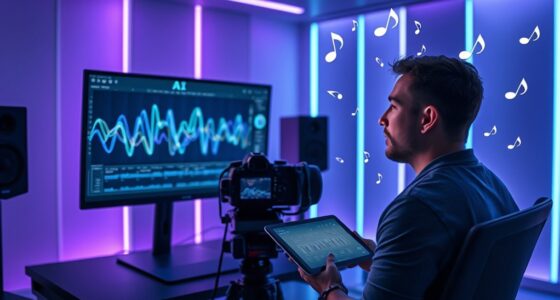AI voice cloning tools for dubbing and localization let you create realistic, natural-sounding voices that closely match original speakers. These tools use advanced algorithms and deep learning to fine-tune voices, capturing subtle traits like tone, pitch, and emotion. They help you save time and costs by reducing re-recording sessions and ensuring authentic emotional resonance across languages. If you continue exploring, you’ll discover how these innovations can transform your voice projects even further.
Key Takeaways
- Advanced voice synthesis creates realistic, emotionally expressive voices suitable for high-quality dubbing and localization projects.
- Speaker adaptation fine-tunes cloned voices to replicate specific vocal traits, ensuring authenticity across languages.
- AI-powered speech analysis enhances emotional nuance capture, improving the naturalness of localized voiceovers.
- These tools reduce production time and costs by minimizing re-recording and enabling quick voice generation.
- Customization features allow precise control over tone, pitch, and pace, maintaining the original content’s emotional integrity.

AI voice cloning tools have revolutionized how we replicate and utilize human speech. With advancements in voice synthesis technology, you can now create highly realistic voices that sound natural and authentic. This innovation is especially impactful for dubbing and localization, where matching the original actor’s tone and emotion is *crucial*. These tools use sophisticated algorithms to analyze voice samples, enabling the generation of speech that closely resembles the original speaker’s voice. This process, known as speaker adaptation, allows you to fine-tune the cloned voice to match specific vocal characteristics, including pitch, cadence, and accent. As a result, you can produce localized content that feels genuine and personalized, eliminating the need for extensive re-recording sessions in multiple languages.
When it comes to voice synthesis, these tools are designed to produce speech that’s not only intelligible but also emotionally expressive. They utilize deep learning models trained on large datasets to learn the nuances of human speech, including intonation and rhythm. This means that the synthesized voice can effectively convey emotion, making dubbed content more engaging and relatable. Speaker adaptation enhances this process by enabling the system to learn from a particular voice sample and replicate subtle vocal traits. Whether you’re working with a well-known actor or a lesser-known voice talent, the technology can adapt to their unique vocal fingerprint, *ensuring* consistency across different projects or languages.
Furthermore, integrating AI-powered speech analysis can improve the accuracy of voice cloning by better capturing emotional subtleties and vocal idiosyncrasies. For dubbing and localization, this combination of voice synthesis and speaker adaptation offers numerous advantages. It *substantially* reduces production time, as you no longer need to coordinate multiple recording sessions with voice actors in various languages. Instead, you can generate high-quality voiceovers quickly and cost-effectively. *Furthermore*, the technology allows for precise control over the voice’s tone, pitch, and pace, giving you the flexibility to match the original content perfectly. This level of customization *guarantees* that the localized version maintains the emotional impact and authenticity of the original, which is *essential* for audience engagement.
Frequently Asked Questions
How Secure Are AI Voice Cloning Tools Against Misuse?
AI voice cloning tools can be vulnerable to misuse, especially in cases of voice theft and unauthorized use. You should be cautious because malicious actors might exploit these tools to impersonate someone or spread false information. While developers implement security measures, no system is entirely foolproof. Protect your voice data and stay informed about potential risks to reduce the chances of misuse and guarantee your voice isn’t stolen or misused.
Can AI Voice Clones Replicate Emotional Nuances Accurately?
Yes, AI voice clones can replicate emotional nuances with impressive emotional authenticity. They analyze tone modulation and subtle vocal cues to mimic feelings accurately. However, the precision depends on the quality of the data used and the sophistication of the model. You’ll find that while they excel at capturing general emotions, some complex or deeply nuanced feelings may still challenge the technology. Overall, they’re continually improving in conveying authentic emotional expression.
What Are the Legal Considerations for Using Cloned Voices?
Remember, “With great power comes great responsibility.” When using cloned voices, you must navigate legal considerations carefully. Guarantee you respect intellectual property rights and obtain proper consent from voice owners before using their likeness. Failing to do so can lead to legal disputes or damages. Always verify licensing agreements and prioritize transparency to protect yourself and maintain ethical standards in your projects.
How Do AI Tools Handle Regional Accents and Dialects?
AI tools handle regional dialects and accent authenticity by analyzing vast speech data to mimic specific pronunciation, intonation, and speech patterns. They learn subtle nuances, so your cloned voice sounds natural and true to regional dialects. You can customize the output to match particular accents, ensuring authentic regional representation. This makes your dubbed content more relatable and culturally accurate, enhancing viewer engagement and trust in the localized material.
Are There Ethical Guidelines for Deploying Voice Cloning Technology?
Yes, there are ethical guidelines for deploying voice cloning technology. You should follow strict consent protocols to guarantee individuals agree to their voice being cloned. Transparency standards are also essential, so you clearly inform users about how the technology is used and its potential risks. By adhering to these principles, you protect privacy and maintain trust, making sure voice cloning is used responsibly and ethically.
Conclusion
So, next time you’re watching a foreign film, remember—it’s probably not the actual actor’s voice you’re hearing, just some clever AI. As these tools become more advanced, voice cloning will make localization effortless, yet somehow, it’ll also make us wonder if we’re truly hearing the real thing. Ironically, technology that aims to bring us closer might just leave us questioning whether we’re listening to authentic voices or convincing imitations.









